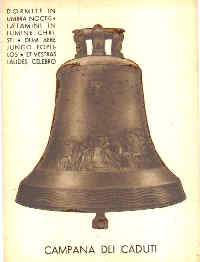
STOP V

|
Roverto |
Contributed by Walter Kudlick The Rovereto Castle Looking to the WestItaly entered World War I on the side of the Allies by declaring war on Austria-Hungary on 23 May 1915, about ten months after fighting had broken out in France and Russia. Despite this late start, more than 5.6 million were called to the colors before the war ended and of these about 39% became casualties, including 650 thousand killed. Italy's primary war aim was to gain control of Austria's Italian-speaking areas known as Italia Irredenta – unredeemed Italy – particularly Trentino in the north and Trieste in the east and in this she succeeded. King Vittorio Emanuele III referred to World War I as one of a series of wars fought for Italy's freedom, while the Austrians considered any of the region's citizens who fought on the Allied side in the Great War as traitors and executed a number of captives for treason.
The picturesque hill town of Rovereto - City of the Ancient Oak -- lies in the Trentino region of the country about halfway between Milan and Venice, and almost due north of Verona. It is located in the valley of the Adige River, on the route leading north to the Brenner Pass through the Alps. Now part of Italy, in 1915 it lay within Austria approximately 10 miles from the border and was fought over by both sides in attack and counter-attack. Today it is the home of Italy's highly recommended Museum of War History, inaugurated in 1921 to house artifacts from several wars but mainly featuring World War I.
 Castle Interior ViewA visit to Rovereto often begins at Milan's central railway station; a huge, gleaming white structure whose architecture exemplifies the style known as "1931 Mussolini Modern," and is itself worth viewing, both on the outside and inside. A round-trip day return ticket to Rovereto costs about $17, including a supplement for a fast train which takes 1 ½ hours to make the trip in one direction. North of Rovereto lies the city of Trento, which has an Alpine Troops History Museum which can also be conveniently visited during the same day by those choosing to drive to Rovereto on the excellent autopista system serving the region.
Rovereto probably began as a Roman settlement but signs of life go back 70 million years in the form of fossilized dinosaur tracks visible from a nearby nature trail. The town was under Austrian rule from the early 16th century until World War I. Looming over the village is a castle on a rocky crag at its western edge. The castle, located at Via Castelbarco 7, contains the Museum of War History which is open from 0830 to 1230 and again from 1400 to 1600 (closed Mondays). Opening hours vary so it is best to check. There is an admission charge of about $6. It is a pleasant half-hour walk from the central train station in Rovereto, via interesting streets, past squares with attractive fountains, and numerous cafes and restaurants. A plaque on one building identifies it as the house where the young Mozart performed his first concert in Italy.
 Artillery Display Ouside the CastleThere are a number of large artillery pieces and plaques along the walls at the base of the castle, including two heroic sculptured heads commemorating Italian martyrs Sottotenente Damiano Chiesa and Tenente Fabio Filzi. These two local men, along with a third – Cesare Battisti – were executed for treason by the Austrians in 1916.
Marvelous views are to be had from atop the castle ramparts: from here can be seen the town's red tile roofs, its church steeples, old world streets and city walls. The River Adige sparkles below, flowing through the town and the mountains which surround it. Atop one of the nearby peaks in an area known as the "Zona Sacra" is the great "Bell of the Fallen," also know as the Maria Dolens, made from the bronze of melted cannons from the Great War. It tolls 100 times every evening at sundown to honor the dead of that conflict and to send forth a message of peace. Also in the Zona Sacra is the Sanctuary of Castel Dante, an ossuary dome housing the remains of more than 20,000 Italian, Czech, Austrian and Hungarian soldiers who died nearby in battle between 1915 and 1918. Hikers can follow a "peace trail" that winds south from this point past World War I battlefields in high valleys and on mountain slopes which were the scenes of much bloody fighting. On the roof of the castle is a simple but moving carved wooden bas relief version of the Pieta sculpture. It portrays Mary with 7 swords piercing her heart and cradling a dead Italian World War I soldier instead of the crucified Jesus. 
Castel Dante Monument
|
|
|
Sources and Thanks: The author contributed the all the text and images used here. |
|


To find other features on La Grande Guerra visit our |
Membership Information  Click on Icon |
For further information on the events of 1914-1918
visit the homepage of |
Additions and comments on these pages may be directed to:
Michael E. Hanlon (medwardh@hotmail.com) regarding content,
or toLeo Benedetti (leoben@silcon.com) regarding form and function.
Original artwork & copy; © 1998-2000, The Great War Society
